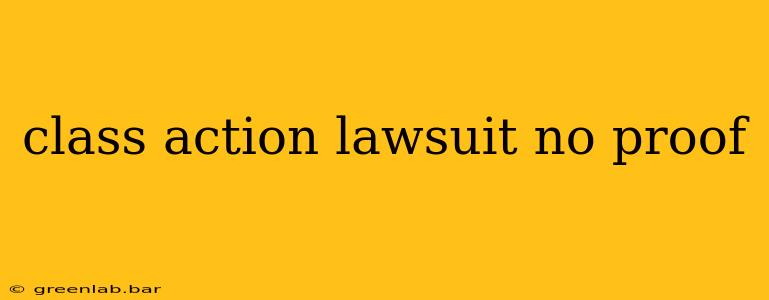Filing a class action lawsuit requires meticulous preparation and substantial evidence. While the allure of collective redress is strong, the reality is that many such suits falter due to insufficient proof. This post delves into the complexities of proving a class action claim when evidence is limited, exploring common challenges and potential strategies.
The High Bar for Proof in Class Action Lawsuits
Class action lawsuits face a higher evidentiary bar than individual claims. This is because the plaintiff represents a large group, and the court must ensure the claims of all class members are sufficiently similar and provable. Simply alleging wrongdoing isn't enough; plaintiffs must demonstrate:
- Numerosity: A significant number of individuals have suffered harm.
- Commonality: The class members share common legal questions.
- Typicality: The named plaintiff's claims are representative of the class.
- Adequacy: The named plaintiff and their legal counsel will adequately represent the class's interests.
These prerequisites, coupled with the need for substantial proof of the defendant's wrongdoing and the resulting damages suffered by the class, create a formidable hurdle.
Common Challenges When Proof is Insufficient:
- Lack of Documented Evidence: Many class action suits hinge on proving systemic wrongdoing, which necessitates comprehensive documentation. Without sufficient records, emails, internal memos, or other evidence, demonstrating a pattern of harmful behavior becomes extremely difficult.
- Difficulty in Establishing Causation: Proving a direct causal link between the defendant's actions and the class members' harm is crucial. This often requires expert testimony, statistical analysis, and compelling evidence demonstrating a clear chain of events. The absence of such evidence weakens the case considerably.
- Problems with Individualized Damages: Even if the defendant's wrongdoing is established, quantifying individual damages for each class member can be a significant challenge. Without reliable data or a consistent method for damage calculation, the lawsuit risks being dismissed or significantly hampered.
- Statistical Challenges: Relying on statistical evidence alone often proves insufficient. While statistics can indicate a trend or pattern, they rarely provide conclusive proof of individual harm. Courts require more concrete evidence to support claims of widespread damages.
- Defendant's Defenses: Defendants often utilize sophisticated legal strategies to challenge the plaintiff's evidence, highlighting inconsistencies or weaknesses in the presented data. This may involve questioning the reliability of witnesses, challenging statistical methodologies, or presenting counter-evidence.
Strategies for Proceeding with Limited Evidence
Despite these challenges, some strategies can help plaintiffs navigate class action lawsuits with limited proof:
- Aggressive Discovery: Thorough discovery proceedings are crucial for unearthing potentially hidden evidence. This involves formally requesting relevant documents, interrogating witnesses, and seeking expert opinions.
- Expert Witness Testimony: Expert witnesses can provide crucial context and analysis, interpreting complex data and establishing the necessary causal links. Their testimony can significantly bolster a weak case.
- Statistical Modeling: Sophisticated statistical modeling can help quantify damages and demonstrate a pattern of harm, even when individual proof is lacking. However, this approach requires careful consideration and robust methodology.
- Settlement Negotiations: Even with limited evidence, plaintiffs might consider negotiating a settlement with the defendant. This allows for a less demanding evidentiary threshold, though it may result in a smaller recovery than a successful trial.
Conclusion: Proceed with Caution and Expert Guidance
Filing a class action lawsuit without sufficient proof is a risky proposition. The challenges are significant, and the likelihood of success diminishes considerably without robust evidence. Before proceeding, it is imperative to consult with experienced class action attorneys to assess the viability of the case and the potential for success. A thorough evaluation of available evidence, a realistic assessment of the legal hurdles, and a pragmatic approach are essential for navigating this complex legal landscape.

